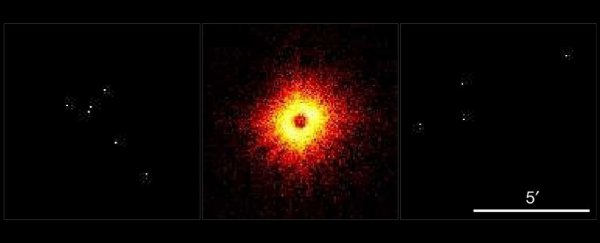The brief, yet colossal eruption of a dead star undergoing a nova explosion has been captured by one of the most powerful X-ray instruments in space.
The joint German-Russian eROSITA telescope, aboard the Spektr-RG space observatory in the L2 Lagrange point (yes, Webb's home), caught for the first time what is known as the 'fireball' phase of a classical nova. This X-ray data has finally confirmed via observation a 1990 prediction about the physics of novae.
The nova in question is known as YZ Reticuli, discovered on 15 July 2020, at a distance of around 8,250 light-years, near the southern constellation of Reticulum. Analysis revealed that this transient brightening was likely the result of what we call a classical nova – an eruption from a white dwarf star.
Here's how it works. A white dwarf star is what we think of as a "dead" star – the collapsed core of a star that was up to around 8 times the mass of the Sun after it reached the end of its atomic fusion (main sequence) lifespan, and ejected its outer material. Other objects of this kind include neutron stars (between 8 and 30 solar masses) and black holes (anything bigger than that).
White dwarfs are small and dense: between the size of Earth and the Moon, roughly, and up to as massive as 1.4 Suns. That mass limit is known as the Chandrasekhar limit: if a white dwarf exceeds that limit, it becomes so unstable that it blows up in a spectacular supernova.
White dwarfs can also – frequently – be in binary systems with larger (albeit less massive) stars. If they're in a close-enough mutual orbit, the white dwarf can siphon material from its binary companion.
That material is primarily hydrogen; it accumulates on the white dwarf's surface, where it heats up. Eventually, the mass becomes so great that pressure and temperature at the bottom of the hydrogen layer are sufficient to ignite atomic fusion on the white dwarf's surface; this triggers a thermonuclear explosion, violently expelling the excess material into space. Hello, nova.
During its second all-sky survey from June to December 2020, eROSITA repeatedly swept the region of sky containing the white dwarf. On its first 22 passes, everything looked just normal, hunky-as-dory could be. On the 23rd pass, however, beginning on 7 July 2020, an extremely bright, soft X-ray source appeared at what was later to be identified as YZ Reticuli – only to disappear again at the next pass, meaning the entire flash couldn't have lasted more than eight hours.
This was 11 hours prior to the optical brightening of the source. This, astronomers say, was entirely consistent with theoretical modeling of the 'fireball' phase of a nova. (Previous observations of a nova fireball were taken in optical wavelengths, and concern the expanding ejecta as the star erupts – a different stage of the nova entirely.)
According to a prediction advanced in 1990, a very brief 'fireball' phase should take place between the runaway fusion that triggers the explosion and the brightening of the star in optical wavelengths. This phase should appear as a soft, short, and bright flash of X-radiation before the star brightens in optical wavelengths.
This, according to theory, happens because the expanding material reaches the white dwarf's photosphere, or 'surface'. For a brief period of time, the outward acceleration of that material matches the inward acceleration due to the star's gravity, causing the white dwarf to heat up and shine with maximum luminosity, known as Eddington luminosity.
As the explosion continues to expand, it cools down, causing the light emitted to shift from the more energetic X-ray wavelengths into the optical. That's usually when we see a nova brighten.
The results have allowed the team to make a few key measurements of the white dwarf in question. These include the precise timing of the thermonuclear reaction, and the temperature evolution of the white dwarf during the entire duration of the nova event. Theoretical work also suggests that the duration of the fireball phase corresponds to the mass of the white dwarf. Using this information, the team derived a mass of 0.98 times the mass of the Sun.
The observation, the team said, was a very lucky one. Over its four-year mission, eROSITA is expected to detect just one or two such fireballs, given the rate of novas in our galaxy.
"With the successful detection of the flash of YZ Reticuli by eROSITA, the existence of X-ray flashes has now been observationally confirmed," the researchers write in their paper.
"Our detection also adds the missing piece to measure the total nova energetics and completes the whole picture of the photospheric evolution of the thermonuclear runaway."
The research has been published in Nature.
